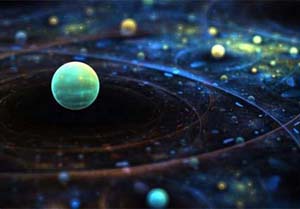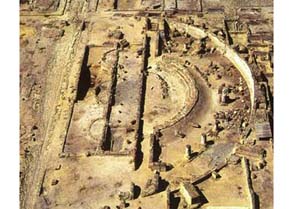 |
|
| Appunti scientifiche |
|
 |
|
| Appunti scientifiche |
|
| Visite: 2168 | Gradito: |
Leggi anche appunti:Dati e costantiDati e costanti Newcomb (1900) Anno sidereo = 365,25636 Le stelleLe stelle Le stelle sono corpi celesti di grandi dimensioni, composti di gas Il fattore di scala e la metrica dell'universoIl fattore di scala e la metrica dell'universo Nella cosmologia relativistica |
 |
 |
HELIOCENTRIC MODEL
 In
astronomy, heliocentrism is the theory according to which the Sun is at the
centre of the Universe. The word comes from the Greek ( helios = sun and
kentron = centre). It was proposed for the first time in XVIth century by the
Polish astronomer and mathematician Nicolaus
Copernicus , and then it was better elaborated and expanded by Kepler.
In
astronomy, heliocentrism is the theory according to which the Sun is at the
centre of the Universe. The word comes from the Greek ( helios = sun and
kentron = centre). It was proposed for the first time in XVIth century by the
Polish astronomer and mathematician Nicolaus
Copernicus , and then it was better elaborated and expanded by Kepler.
But the heliocentric model was not a creation of Copernicus. In fact, Aristarchus, a Greek astronomer and mathematician, had already theorised a model similar to this one. We have nowadays only little information about his theory, thanks to a passage taken from "Concerning the face which appears in the orb of the moon" written by Plutarch. One of the characters talking in there, the philosopher Cleanthes, openly criticised Aristarchus and his model saying that he should be charged with impiety for "having moved the Hearth". But at that time, Aristarchus attracted very little attention and the heliocentric model was abandoned till Copernicus revised and rielaborated it a few centuries after.
 In 1543
the publication of the "De revolutionibus orbium coelestium" written by
Copernicus challenged the geocentric model threatening his future existence.
This model asserted that the Earth and
the other planets revolve around the Sun. The circular movements of the
planets were maintained ( Kepler will assert that planets have an elliptical
orbit only later). At first, this new model was not accepted even if it gave a
simpler explanation to the retrograde motions of the planets and of the
variation of their distance from the Earth because it posed big problems for
both natural science and Scripture. So, for many years, the geocentric system
was still held.
In 1543
the publication of the "De revolutionibus orbium coelestium" written by
Copernicus challenged the geocentric model threatening his future existence.
This model asserted that the Earth and
the other planets revolve around the Sun. The circular movements of the
planets were maintained ( Kepler will assert that planets have an elliptical
orbit only later). At first, this new model was not accepted even if it gave a
simpler explanation to the retrograde motions of the planets and of the
variation of their distance from the Earth because it posed big problems for
both natural science and Scripture. So, for many years, the geocentric system
was still held.
The invention of the telescope in 1609 made by Galileo Galilei, who also made many others discoveries like the satellites of Jupiter, or the presence of mountains and craters on the surface of the Moon, threatened again the principles of geocentrism. In December 1610, thanks to the telescope, Galilei found out that Venus showed all the phases, as the Moon. But this observation was completely incompatible with the Ptolemaic system, while it was a proof and a direct consequence of the heliocentric system proposed by Copernicus. In fact, according to Ptolemy, Venus' deferent and epicycle were inside the sphere of the Sun; that means that if Venus was between the Earth and the Sun, its phase should have always been crescent or all dark. Instead, if Venus was beyond the Sun, its phase should have always been gibbous or full. But Galilei saw Venus, at first full, and then crescent. This was the proof that Venus' epicycle could not be entirely inside or outside the orbit of the Sun.
Then, Galileo discovered that our galaxy, the Milky Way is made of millions of stars that are more distant to the Earth than the planets. As a result, Ptolemaics abandoned some of their principles and started believing in a new model: the Tychonic system. According to this theory, the Earth was still the centre of the universe and the Sun revolved around it, but all the other planets revolved around the Sun. But the time of geocentrism was at that point finished.
In 1619, Johannes Kepler constructed his three laws based on heliocentric model and on the fact that planets move on elliptical paths. These laws are:
 Using
these laws, Kepler was the first astronomer to predict a transit of Venus ( for
the year 1631). A transit of Venus happens when Venus passes between the Sun
and the Earth, obscuring a small part of the Sun. During a transit, Venus is
seen from the Earth as a small black disk moving across the Sun. In 1687, Isaac
Newton asserted his law of universal gravitation, according to which, the Earth
and all the other planets are kept together by a force called gravitation.
After this discovery, scientists were finally able to construct a plausible
heliocentric model of the solar system and to demonstrate it empirically.
Using
these laws, Kepler was the first astronomer to predict a transit of Venus ( for
the year 1631). A transit of Venus happens when Venus passes between the Sun
and the Earth, obscuring a small part of the Sun. During a transit, Venus is
seen from the Earth as a small black disk moving across the Sun. In 1687, Isaac
Newton asserted his law of universal gravitation, according to which, the Earth
and all the other planets are kept together by a force called gravitation.
After this discovery, scientists were finally able to construct a plausible
heliocentric model of the solar system and to demonstrate it empirically.
But the biggest problem that the heliocentric model had to face in order to be accepted, was the reactions of the religious authorities . Galileo defended heliocentrism saying that it was not contrary to the Bible. He said that it's important while reading the Scripture not to take every single word literally, because it is a book of poetry and songs and not a book of history and this was also the attitude suggested by St. Augustine. He wrote "Dialogue concerning the two chief world systems", his best work, published in 1632, in which he compared the two models, the geocentric and the heliocentric, and showed the validity of the second one.
The Church, at first, authorised the publication of the book, but then Galileo was put on trial in 1633 and condemned to home arrest till his death. Nicolaus Copernicus published the definitive statement of his theory in "On the revolution" in 1543, the year of his death. But he began to write it in 1506 and finished it in 1530, even if he was in good relation with the Church and he had dedicated his work to Pope Paul III. The published version of the book opened with an unsigned preface written by Andreas Osiander, a German Lutheran theologian, that stated that the system proposed was a pure mathematical device and was not supposed to be the reality. Because of that, at first, the work of Copernicus caused very little debate. Only some Dominicans believed that this teaching should be banned. However, some protestants, openly criticised it during the XVIth century. Martin Luther once said:
 But over time, the Catholic
Church became the first enemy of the heliocentric model. In fact, starting with
Pope Urban VIII, the Church became more and more protective towards geocentrism
and the Pope himself became hostile to those who defended that because also the
theocentric world view of humankind was criticised. The debate progressed and
the Church took a harder attitude against Copernican ideas. However, there was
someone that considered the heliocentric model at least a model correct from
the point of view of mathematic. For example, Cardinal Roberto Bellarmino,
said:
But over time, the Catholic
Church became the first enemy of the heliocentric model. In fact, starting with
Pope Urban VIII, the Church became more and more protective towards geocentrism
and the Pope himself became hostile to those who defended that because also the
theocentric world view of humankind was criticised. The debate progressed and
the Church took a harder attitude against Copernican ideas. However, there was
someone that considered the heliocentric model at least a model correct from
the point of view of mathematic. For example, Cardinal Roberto Bellarmino,
said:Therefore, Bellarmino was against the teaching of this theory and accepted it only if considered an hypothesis and in 1616 he delivered a papal command not to "hold or defend" the heliocentric idea. In 1633 the trial of Galileo took place,. He was accused of heresy. Only in 1757 the Church, in the person of Pope Benedict XIV suspended the ban on heliocentrism, after the publication of Newton's work.
 |
| Appunti su: first heliocentric model, |
|
| Appunti Ecologia ambiente |  |
| Tesine Archeologia |  |
| Lezioni Geografia |  |